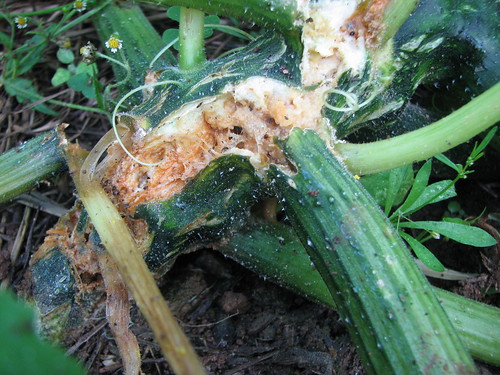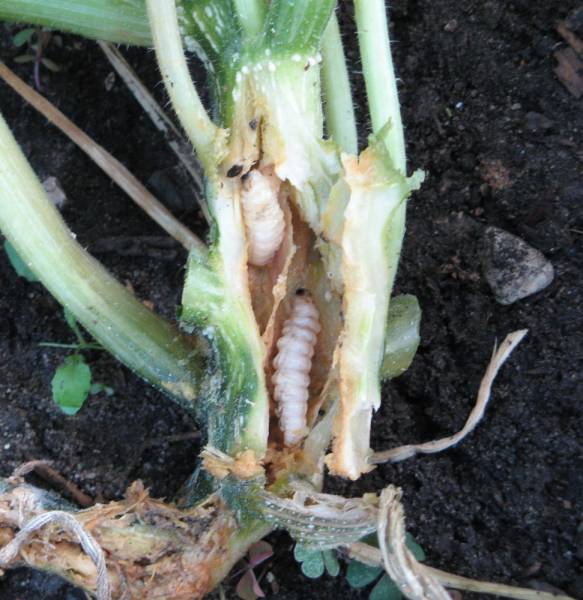As each month goes by, we get more efficient and proficient at the activity that happens most during that part of the season. In March and April, we honed our seed-blocking technique. In May and June, we worked our way through transplanting and direect seeding. Now in July, we’re learning more and more about two disparate activities: harvesting and insect pest identification/defense.
Harvesting is a joy. To twist a summer squash (or 13) off the vine in the early morning gives a real sense of satisfaction because I knew most of these plants as seeds that we held in our hands and planted (or soilblocked and then transplanted) in a time that seems So Long Ago now that the sprawling viney greenery and broad leaves blanket the rows and dominate the paths. Multiply that feeling by the cucumbers, the tomatoes, ground cherries, radishes (though they’re quicker), watermelons, basil and lettuces (though they were often more frustrating than satisfying), and you can start to get a sense of what makes July amazing.
Pest management, on the other hand, is a matter of overcoming my personal ignorance of who’s good and who’s bad in the field and the squeamishness that accompanies ruthless decimation of the ones who fall on the bad side of that judgement. The first plants hit were the eggplant, where flea beetles made lace of the leaves, but the distinction of Most Affected goes to the squash line in the cucurbit family. In the last week and a half, we have discovered what looked like bacterial wilt on the 8-ball zucchini (which is transmitted by the cucumber beetle), squash bug eggs and nymphs on nearly all the summer squash and pumpkins, and squash vine borers in most of the pumpkins and some of the summer squash. We’re also watching the pumpkins’ leaves for squash mosaic virus signs (another one transmitted by the cucumber beetle) and powdery mildew.
Most of the information I’ve seen recommends prevention as the best means of protection. Perhaps next year all the squash starts as well as the eggplants and brassicas will wear row cover as soon as they are transplanted. THIS year, however, we are into the stage where the solution seems to be Squash the Bugs to Save the Squash.
 Cucumber beetles, we have learned, come in two patterns: the yellow striped kind and the orangey red spotted kind (which looks rather like ladybugs, but somehow… off. I think it’s the red on the throax, where ladybugs’ thorax is black with white spots). They fly, and Amber has used sticky traps and oil-on-water traps for a lot of them. When I see one, I squish it. It’s not too bad. They’re small and neither very crunchy nor very gooey.
Cucumber beetles, we have learned, come in two patterns: the yellow striped kind and the orangey red spotted kind (which looks rather like ladybugs, but somehow… off. I think it’s the red on the throax, where ladybugs’ thorax is black with white spots). They fly, and Amber has used sticky traps and oil-on-water traps for a lot of them. When I see one, I squish it. It’s not too bad. They’re small and neither very crunchy nor very gooey.
Squash bugs are bigger than cucumber beetles as adults, smaller as nymphs.
 They lay these beautifully orange/bronze eggs in groups on or under the squash leaves. The eggs are tough, and once I’ve picked them off the leaves, I rub them against the knee of my jeans to break them. There’s a lovely maroon spot there now. Once they hatch, the squash bug nymphs congregate to feed near the eggshells. The part that really makes me squirm is flipping a leaf over to find dozens of the tiny nymphs. They all get easily squashed by hand. As the nymphs grow, they become small, white and pear-shaped.
They lay these beautifully orange/bronze eggs in groups on or under the squash leaves. The eggs are tough, and once I’ve picked them off the leaves, I rub them against the knee of my jeans to break them. There’s a lovely maroon spot there now. Once they hatch, the squash bug nymphs congregate to feed near the eggshells. The part that really makes me squirm is flipping a leaf over to find dozens of the tiny nymphs. They all get easily squashed by hand. As the nymphs grow, they become small, white and pear-shaped.
 They also get squished by hand. It’s rare that I find an adult, and I like to have gloves on to squash them as they’re NOT so easy to kill. Jake and I joked that they go from being squash bugs to being squashed bugs.
They also get squished by hand. It’s rare that I find an adult, and I like to have gloves on to squash them as they’re NOT so easy to kill. Jake and I joked that they go from being squash bugs to being squashed bugs.
Squash vine borers hatch out of the earth and bore their way into the base of a squash vine – hence the name.
 The plants don’t often survive, according to the ever-knowledgeable internet. Once the larva is in the vine, what can be done is to split the vine open with a knife, find the larva (a squishy white grub-looking thing) and kill it. Then bury the stem of the plant up to the first leaf, or however high you cut it open. This encourages the plant to heal and grow roots out of that section of the stem. I cut open about half of our affected pumpkins and found and eliminated many squash vine borer larvae.
The plants don’t often survive, according to the ever-knowledgeable internet. Once the larva is in the vine, what can be done is to split the vine open with a knife, find the larva (a squishy white grub-looking thing) and kill it. Then bury the stem of the plant up to the first leaf, or however high you cut it open. This encourages the plant to heal and grow roots out of that section of the stem. I cut open about half of our affected pumpkins and found and eliminated many squash vine borer larvae.
 The other half of the plants I buried without cutting open the vines, as an experiment of sorts. All but two of them survived the weekend. We may have a bounty of pumpkins and squash yet. My fingers are crossed.
The other half of the plants I buried without cutting open the vines, as an experiment of sorts. All but two of them survived the weekend. We may have a bounty of pumpkins and squash yet. My fingers are crossed.


Wow. Great post, Anna. with pictures. Squash Bugs become Squashed Bugs. Squash the Bugs, Save the Squash!
I love your website and the story of your farming.